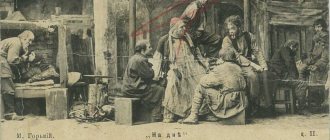Character
The main character of the tragedy is an intelligent person. This is manifested not only in the fact that he studied at the university, but also in the fact that he constantly strives for the truth. He does not consider himself better than everyone else, because he knows that he has room to strive. Hamlet is far from a smug and far from arrogant person.
Hamlet is a man of honor. He will never be able to forgive lies and close his eyes to the deception of loved ones. This speaks of the inflexibility of the protagonist’s character. The clash between the character and the outside world reveals the main conflict of the work: man and society. Hamlet cannot live in such a contradictory world in which evil and cruelty reign. The image of the central character is determined by the social picture, Hamlet is the birth of an era.
The external conflict of the tragedy develops into an internal one. Hamlet feels his loneliness; he is not like the people around him. This becomes the reason for constant reflection about one’s own presence in the world.
Essay on Hamlet Shakespeare 9th grade
Municipal state educational institution "Skalistskaya secondary school" Lesson of foreign literature in 9th grade. Teacher: Kenzhebaeva L.I. “Should we submit to the blows of fate or should we resist?” Moral problems in W. Shakespeare's tragedy "Hamlet" (2 hours) Purpose of the lesson: to introduce students to the content of W. Shakespeare's tragedy "Hamlet". Objectives: educational - to identify “eternal problems” in the work of William Shakespeare, developing - to develop an understanding of a dramatic work, to work on the development of monologue and dialogical speech of students, to develop acting skills, inculcating - to cultivate an active life position, intransigence to meanness, cowardice, greed . Equipment: portraits of Shakespeare, photographs of I. Smoktunovsky in the role of Hamlet. Methodological techniques: introductory speech by the teacher, literary montage “My Hamlet”, analysis of the work, expressive reading of excerpts of the work, written answer to the question, work in groups, literary reference, report on the theater. Vocabulary work. Tragedy is a dramatic genre that is built on a tragic (initially unresolvable) conflict between the hero and circumstances or on an equally insoluble conflict of internal motives in the hero’s soul. A tragic conflict (the tragic is often based on it) cannot be safely resolved, and often has no solution at all. There are two types of tragic conflicts: external, when a person confronts unfavorable external conditions, and internal, when values that are equally important to him, but incompatible, conflict in the hero’s soul. Often external and internal tragedy are combined and reinforce each other. Lesson Plan I. “To unravel the mystery and meaning of existence.” (Identify the perception of the play and create a mindset for analyzing the work.) II. "It's not just about murder." (Show the complexity and integrity of Hamlet’s nature.) III. “Reality has become different for him.” (Build the conflict of the tragedy; analyze the system of relations against which Hamlet opposes) Lesson progress I. “To unravel the mystery and meaning of existence.” 1. Introductory speech by the teacher. (It is advisable that the children have watched a play or film by this time.) How does our modern reader perceive Hamlet? It is possible that his feelings and thoughts will coincide with the opinion of Goethe, who explained the tragedy by the impossibility of the task entrusted to the hero, or the reader will find Belinsky’s point of view closer. The Russian critic believed that weakness of will is an overcomeable condition, that Hamlet becomes a fighter against the depraved and oppressive court. It is less likely that the views of a contemporary coincide with the assessment of I. S. Turgenev. In his article “Hamlet and Don Quixote,” the author of “Fathers and Sons” reduced the content of Shakespeare’s image to callous egoism, indifference, and contempt for the crowd. In contrast to Hamlet, Don Quixote is distinguished by his nobility and humanity. But in Shakespeare's tragedy, Hamlet is concerned about the fate of the country. Selfishness is the least characteristic of him. Polemicizing with those who focus on Hamlet's weakness and indecisiveness, G. Kozintsev in his film tragedy portrays Shakespeare's hero as consistently purposeful, ready to fight evil to the end. The performer of the role of Hamlet, I. Smoktunovsky, strives to reproduce the powerful forces hidden in a person who rebelled against evil. Thanks to this, “the viewer does not doubt for a moment that this is exactly what a Danish prince should be...” Shakespeare’s tragic feeling is not identical to the tragic worldview of one hero. It's more significant. It permeates all of Shakespeare's work of the second period. Comparing Hamlet with other characters in Shakespeare's tragedies, we can say that Hamlet is consistently aware of his tragedy and fights not blindly, but clearly imagining what kind of opponent he faces. The disparate facts of life are gradually connected together in the hero’s mind. Hamlet perceives the profound changes that have taken place in the country and laments that everything is going for the worse. Shakespeare's hero is shown in close-up. The scale of Hamlet’s personality increases because not only the contemplation of all-encompassing evil characterizes the hero, but also combat with the vicious world. Hamlet's opponents, in turn, are not idle, they accept the challenge. They should not be underestimated. They determined the tragedy of Hamlet. They “shaken” the century. They are specific carriers of vice, the perpetrators of lawlessness and debauchery. They are hostile not only to Hamlet. 2. Implementation of homework. 1) Literary montage (composed of monologues, replicas of the hero) “My Hamlet”. 2) Exchange of views. II. “Reality has become different for him.” 1. Implementation of homework. 1) Literary information about the tragic and tragedy (the terms “tragedy”, “tragic” are introduced). 2) A short message about the theater of the Shakespearean era (lack of scenery, division into acts, conventions of time). 2. Analysis of the work. Defining the genre of the work as tragedy, is it possible to agree with Vygotsky, who says that “Hamlet is a “tragedy of tragedies”, where the main thing is not what happens, but what Hamlet thinks about what is happening, what is struggling inside him, in his soul and thoughts"? Support your answer with examples from the text. – Can we say that the idea of this work “follows” from Shakespeare’s tragic worldview? Define the idea of the play and what motivates it? (Shakespeare strives to show how terrible the reigning inhumanity is. It is motivated by the logic of the characters and the intention of the work.) - Please trace how the main conflict of the tragedy develops from beginning to end? (At first, the conflict is barely noticeable, but is already of a social nature. There is a feeling of imminent disaster, the consciousness that the normal course of life has been disrupted. Hamlet is not the only one expressing his concern. Having seen the ghost, Horatio says: “I see in this a sign of some strange unrest for the state." Marcellus echoes him: “Something is rotten in the Danish state." The internal conflict is also clearly indicated: he cannot discount his personal insult. He cannot bear to see the “satyr” Claudius on the throne, replacing the “valiant king.” it is difficult to bear the death of a deeply revered father. At the same time, Hamlet is able to characterize the situation in the country more maturely than his friends did. If they had a vague premonition of trouble, then Hamlet sees in the very riotous lifestyle of the new monarch one of the reasons for the decline of Denmark: Dumb revelry to the west and east Disgraces us among other nations... Hamlet confronts the king. Condemns him, but the conflict, having not received an impetus, cannot yet develop further. While Hamlet expresses his dissatisfaction verbally. To contrast Hamlet’s difficult mental state, contemplating suicide, the author depicts the king’s complacency. He was touched by the prince's agreement to stay at court and not go to Wittenberg. True, it is not entirely clear to the reader why Claudius is interested in the presence of his nephew. But such complacency alarmed Hamlet. When Hamlet meets the ghost, he learns about the violent death of his father. The prince wants to punish the murderer immediately. The direct conflict with Claudius and other events unfolding in the play are inferior in their significance to the spiritual drama of Hamlet, which is highlighted. Hamlet's internal drama is that he repeatedly torments himself for inaction. If Hamlet dared to immediately take revenge for the death of his father, it would be a simple murder, but he wants to change the world of evil and unfreedom. He realizes that he cannot do this alone. When Hamlet reveals the meaning of the events taking place at court, he judges Denmark and the time more harshly than before. After the actors play, the course of action is characterized by a sharp escalation of the struggle. This is Hamlet’s major victory.) – What determines the movement of the plot? (The fight with Claudius. Each of the warring sides seeks to seize the initiative and impose its will on the enemy. It is not psychological analysis, but the dynamics of the unfolding battle, the tactical maneuvers of the fighters that determine the movement of the plot. Success is now on one side, then on the other. Having taken command positions after the performance, Having struck the spy Polonius, Hamlet is then forced to defend himself from the enemies pressing on him. He either defends or attacks. This is seen in the example when the spies Rosencrantz and Guildenstern are about to be executed by the English king. Then Claudius makes a clever move by inciting Laertes to kill Hamlet. This is not a fair fight, but a pre-arranged murder.) – When does Hamlet’s internal drama reach its highest point of tension, i.e., its climax? (In Act III, Hamlet’s internal drama reaches its highest point; the crisis is most acutely expressed in the monologue that begins with the words “To be or not to be”?) III. "It's not just about murder." 1. Expressive reading of the monologue “To be or not to be”? (Either the recording is listened to, or the teacher himself reads, or a student prepared in advance.) 2. Conversation. – Determine the role of the monologue in the artistic fabric of the entire work. (This monologue became famous and acquired the significance of a complete lyric poem, unusually bright in its expressive power. It completes a certain stage of the hero’s spiritual development and is organically connected with the artistic fabric of the entire work. Hamlet’s spiritual crisis is outlined here, from which he emerges victorious, according to Belinsky’s definition. If Hamlet himself is still weighing his options, thinking about which path to choose, then life has already forced him to start fighting. First, thought comes into play - sharp, merciless to himself and to the way the world around him lives, and then Hamlet’s behavior changes .) – What decisions are contained in the monologue? (One solution is “to die, to fall asleep” - and that’s all. The theme of suicide already arose in Act I, here it is persistently developed. “Fear of something” knocks Hamlet down after death, he inspires Hamlet to “endure our misfortunes,” i.e. . he is frightened by the unknown. The second decision is “to take up arms on the sea of turmoil, defeat them with confrontation." At first, this question remains without a clear answer. Then he comes up with a “form” of behavior for himself - to pretend to be insane. Polonius was the first to experience Hamlet’s “madness” .) – Why is the monologue suddenly interrupted by the appearance of Ophelia? (There is no surprise in this. This is inherent in Hamlet; he once again reproaches himself for indecision, since the inconsistency and duality of Hamlet’s thinking are traits inherent in him.) – For whom does Hamlet’s “madness” cause undisguised anxiety and even confusion? Do they believe him? (“Hamlet’s madness causes undisguised anxiety and even confusion among the courtiers and Claudius himself. They do not believe him. Let us remember the words of Polonius: “Though it is madness, there is consistency in it.”) - What moment can be called the culmination of the struggle between Hamlet and Claudius? What does Shakespeare call him? How did we see Hamlet here? (The real battle began between Hamlet and Claudius after the performance, the famous “mousetrap”, with the help of which Hamlet managed to “lasso the king’s conscience.” Hamlet rebelled against the prison world, and Claudius was the main jailer. If his “madness” was a secret war , then the performance was a direct attack, the purpose of which was to expose to everyone the appearance of a criminal who seized the throne by killing his brother. Hamlet appears before us changed. All doubts and hesitations have been discarded. Decisiveness of action, ingenuity of mind, creative enrichment of a play written by someone, directing lessons actors, a subtle psychological calculation of Claudius's weakness - all this stormy activity contrasts with the former duality and constant self-flagellation that were previously characteristic of him. The arrival of the actors was an unexpected event. However, Hamlet himself was internally prepared at the time of their arrival to use the performance to expose the king. In turn, the actors understood Hamlet and their task from the first time. They respected him, and he deeply knew and loved the theater.) - Explain the role of Laertes in the tragedy. (On the one hand, “elementary revenge”, and on the other, this is a clever move for Claudius. It is he who sets up Laertes to kill. The murder of Hamlet was supposed to decide the outcome of the struggle between him and Claudius.) According to Belinsky’s definition, “the second place in the tragedy is given to Ophelia. Her tragedy reinforces the general painful mood caused by the “omnipotence of evil.” Prove the validity of this statement with examples from the text. (The relationship between Hamlet and Ophelia is not always clear. He assures her that “forty thousand brothers” cannot love as much as he does. But in the tragedy there is not a single scene that would convincingly confirm these words; he has some kind of grossly ironic attitude towards Ophelia. For example, he advises her to go to a monastery. Her death is accelerated by weakness, but is not caused by it. The reader loves Ophelia even when she obediently serves Polonius, who was watching Hamlet. She is naive and gullible as much as Hamlet is incredulous. Suspecting, that Hamlet is mad, she exclaims: Oh, what a proud mind is slain! The nobleman, the Fighter, the scientist - the look, the sword, the tongue; The color and hope of the joyful power. The statement about Hamlet is decisive. However, we remain in the dark as to whether she loved the prince , what place he occupied in her life - this remained a secret to everyone. She does not play the role of a madwoman, but really goes crazy, so the reader’s sympathy is always on Ophelia’s side.) - What kind of relationship did Hamlet have with Gertrude? (He accuses her that she so quickly succumbed to Claudius’s persuasion and, “without wearing out her shoes yet,” marries him. But she is the only one who, under the influence of Hamlet, is internally cleansed, comprehends the harmfulness of her connection with the criminal Claudius. A cruel accusation, presented to her by her son is irresistible. And the queen, unlike her second husband, has not lost her conscience. In complete despair, she confesses to Hamlet: ... You directed your eyes straight into my soul, And in it I see so many black spots that nothing can remove them ...) 3. R/r. Give a written answer to the question: “How many facets are there in the complex image of Hamlet?” Draw a conclusion. He is irreconcilably hostile to Claudius, the prison world. He is friendly towards the actors. He is rude and ironic in his interactions with Ophelia. He is courteous to Horatio. He doubts himself. He acts decisively and quickly. He's witty. He skillfully wields a sword. He is afraid of God's punishment. He is blasphemous. He denounces his mother and loves her. He is indifferent to succession to the throne. He remembers his father the king with pride. He thinks a lot. He cannot and does not want to restrain his hatred - this whole range of changing colors reproduces the greatness of the human personality, and is subordinated to the revelation of the tragedy of man. – Name the bloodiest scene in the entire tragedy. Determine her role in the tragedy. (Critics call the play “Hamlet” the bloodiest of all Shakespeare’s tragedies. In the finale, Queen Gertrude is poisoned, Laertes and Claudius are killed, Hamlet dies from his wound. L. N. Tolstoy questioned the reliability of such a conclusion to the plot, when all the main characters die almost simultaneously . It seems that we have no reason not to believe Shakespeare. The death of each character has its own special explanation. The most tragic is the fate of Hamlet, since in his image true humanity, combined with the power of the mind, finds the most vivid embodiment. According to this assessment, his death is depicted "as a feat in the name of freedom." The death of Claudius is not at all tragic. Even with his death he could not atone for the crimes he committed. The death of Queen Gertrude is tragic, but her death is incomparable in its significance with the loss that society suffered by losing Hamlet. Each death is -appreciated by the author. Its historical significance, its objective meaning was that Hamlet’s grief, his protest coincided with the feelings arising among the people.) - What artistic techniques does Shakespeare use to reveal the image of Hamlet? 4. Work in groups to answer this question. First group. Techniques in the field of artistic speech (the role of monologue, allegories, philosophical conversations, irony). (The hero’s spiritual drama is revealed in monologues, and this means is also used to convey the entire process of the hero’s self-analysis and assessment of the environment. Through allegory, Hamlet expresses his attitude towards his opponents, as well as towards Ophelia. Allegories emphasize the distance between Hamlet and the court. Philosophical the conversation with the gravediggers is ambiguous. It reveals Hamlet's closeness to the people, sociability, which is not observed in Hamlet's conversations with the king and the courtiers. For a while, Hamlet's gloomy mood changes. He jokes cheerfully, sincerely enjoys the wit of the gravediggers. Hamlet seems to have forgotten about his former self fear of the afterlife and freely fantasizes about the vicissitudes of fate in the unearthly world. His conversation with the actors has the same meaning - this is a kind of folk background. This is a release of tension. Irony helps to separate the most significant, peak moments of the tragic action.) The second group. Techniques in the field of composition. (“Distracting” episodes are introduced (conversation with actors, conversation with graves). The image of Hamlet is deepening here, his humanity becomes not as harsh as in the scenes where he fights. The warmth of the soul, the inspiration of the artist - these are new strokes in the portrait of Hamlet. ) The third group. Receptions in the field of artistic detail. (The rejection of the right to the throne: after the death of his father, he had the right to the throne, as he reached the age of majority. He does not seek to sit on the throne. Turn on this Shakespeare in the tragedy, she would lose her social essence of the struggle. When Horatio speaks of the deceased monarch, that “This was the King of the King,” Hamlet clarifies: “He was a man, a man in everything.” This is a true measure, the highest criterion of the humanism of the Renaissance.) The conclusion. - So what is the essence of "Hamletism"? Homework. Write an essay on the topic "Hamlet in poetry of the 20th century."
Philosophical content
Hamlet is a very smart and educated person. In his mouth, the author puts serious thoughts about the essence of society and the world as a whole. In Shakespeare's tragedy there are quite a few monologues of Hamlet, among which the well-known thoughts of everyone stand out: “To be or not to be?” All monologues reveal the essence of the image, its internal contradictions.
Hamlet is a man of a new era, expressing the philosophical worldview of the Renaissance. The hero of Shakespeare's tragedy is a philosophical category, an “eternal image” that is interesting for its psychological traits.
Several interesting topics
- Final
- What does the story “French Lessons” make you think about?
In 1973, the famous Russian and Soviet writer Valentin Rasputin wrote the story “French Lessons”. The hero of the story is an eleven-year-old boy who comes from a remote village to the regional center - Ship Grove
The artist painted this picture in 1898. This is a grove of ship pines, beautiful, tall, stately beauties. With a mighty evergreen crown, where sunlight rarely penetrates. - Finogenova's bright day
There are many parameters by which ordinary viewers evaluate works of art. These include: the actual author’s plan, stylistic and technical features of its implementation - The main characters of the play Romeo and Juliet
Shakespeare's work “Romeo and Juliet” is still reread by millions of people around the world. This play perfectly shows human relationships.





